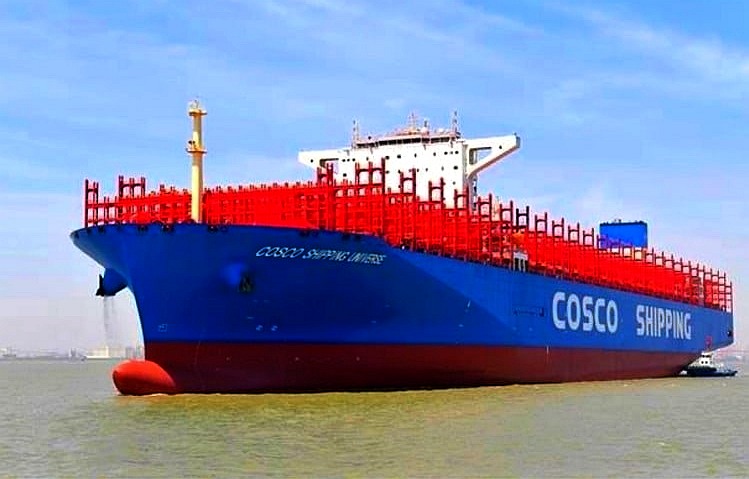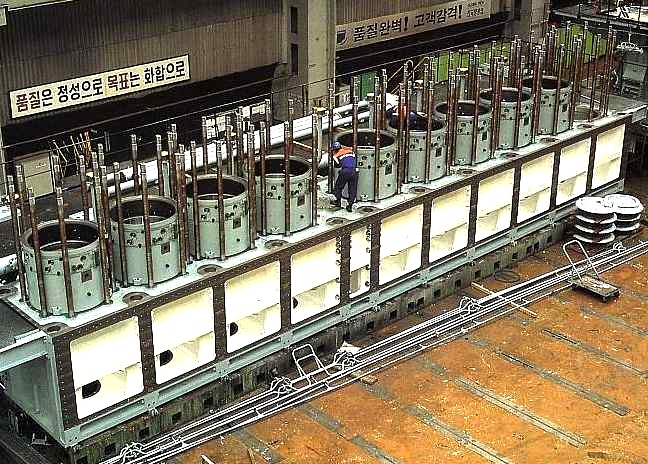|
COSCO SHIPPING UNIVERSE 3rd CONTAINER SHIPS
ABOUT - CLIMATE CHANGE A-Z - CIRCUMNAVIGATION - CONTACTS - DONATE - FOUNDATION - HOME - OCEAN PLASTIC A-Z Please use our A-Z INDEX to navigate this site
COSCO SHIPPING UNIVERSE - Chinese owned and operated container ships to ferry consumer products to the rest of the world to keep their economic boom alive.
3. COSCO SHIPPING UNIVERSE
With a little less carrying capacity: 21,237 TEU than the former,
this giant holds the 3rd position in this list of gas
guzzlers. She is 400 metres long and 58.6 metres wide,
dimensions very similar to other giant fossil fueled carriers. Originally built by
the China State Shipbuilding Corporation (CSSC) and later transferred
to China Ocean Shipping Company Limited (COSCO) in 2018.
COSCO SHIPPING UNIVERSE (IMO: 9795610) is a Container Ship registered and sailing under the flag of Hong Kong. Her gross tonnage is 215553 and deadweight is 198485. COSCO SHIPPING UNIVERSE was built in 2018 by SHANGHAI WAIGAOQIAO. Her length overall (LOA) is 399.9 m, beam is 58.6 m. The ship is operated by COSCO SHIPPING LINES CO LTD.
China COSCO Shipping Corporation Limited, also referred to as the China COSCO Shipping Group or China COSCO Shipping, is a Chinese business conglomerate and state-owned enterprise headquartered in Shanghai.
The vessel is equipped with three ABB A180-L two-stroke turbochargers to match the diesel main engine and four ABB TPL67-C33 4-stroke turbochargers to match four auxiliary engines.
The first flagship mega container ship in the Universe series, COSCO Shipping Universe, was delivered in June 2018 by Jiangnan Shipyard (Group) Co. Ltd. The vessel is equipped with three ABB A180-L turbochargers to match the two-stroke diesel main engine and four ABB TPL67-C33 turbochargers to match the four-stroke auxiliary engines.
COSCO SHIPPING Lines Co., Ltd (“COSCO SHIPPING Lines”), is an enterprise specially engaged in international and domestic container shipping and related services, have a world leading container fleet, a service network with global coverage. The company has a total of 373 container vessels, with a total capacity of 1.9 million TEUs, ranking 4th place in the world, and 1st place in Asia. COSCO SHIPPING Lines operates 362 international and domestic shipping routes, consisting of 227 international services (including international feeder services), 49 domestic services, 86 Yangtze River and Pearl River shipping services, covering 289 ports in 90 countries and regions worldwide.
BOOKINGS
For booking, please contact our booking and customer service:
STANDARD
Modern containers ships are cargo ships designed to carry their cargo in standardised steel boxes, using a technique called “Containerization”. This type of ocean transport contributes about 90% of non-bulk cargo movement worldwide. This is how you get your televisions, computers, fruits and spare parts. Cars are generally transported by ferries, though some collector vehicles are delivered in containers.
Fossil fuelled container ships that belch clouds of fumes as they ply the ocean may one day be a thing of the past. Shipping will continue without those who fail to adapt to changing circumstances such as global warming and zero carbon fleets by 2100, as part of the IMO's ocean cleanup objectives. In the meantime here are the top ten biggest gas guzzlers and potential ocean polluters in the world @ October 2019.
Why
Are They So Big?
The use of fossil fuels raises serious environmental concerns. The burning of fossil fuels produces around 21.3 billion tonnes (21.3 gigatonnes) of carbon dioxide (CO2) per year. It is estimated that natural processes can only absorb about half of that amount, so there is a net increase of 10.65 billion tonnes of atmospheric carbon dioxide per year. Carbon dioxide is a greenhouse gas that increases contributes to global warming. A global movement towards the generation of low-carbon renewable energy is underway to help reduce global greenhouse gas emissions.
SIX STEPS TOWARD A COOLER PLANET
1. TRANSPORT: Phase out polluting vehicles. Governments aim to end the sale of new petrol, and diesel vehicles by 2040 but have no infrastructure plan to support such ambition. Marine transport can be carbon neutral with development..
2. RENEWABLES: Renewable energy should replace carbon-based fuels (coal, oil and Gas) in our electricity, heating and transport.
3. HOUSING: On site micro or macro generation is the best option, starting with new build homes to lock carbon.
4. AGRICULTURE: We need trees to absorb carbon emissions from a growing population, flying, and to build new homes. Reducing food waste and promoting less energy intensive eating habits such as no meat Mondays.
5. INDUSTRY: Factories should be aiming for solar heating and onsite renewable energy generation.
6. POLITICS: - National governing bodies need to adopt rules to eliminate administrative wastages, to include scaling down spending on war machines, educating the public and supporting sustainable social policies and financing that mesh with other cultures.
These marvels of engineering excellence got us where we are today, technology wise, but threaten to destroy the planet if we do not adapt in time to repair at least some of the damage we have done.
FOSSIL
FUEL HEALTH HAZARDS
One of the world's largest diesel engines being assembled in Japan.
1995 COP
1,
BERLIN, GERMANY
2022 COP 26 - Will they have applied the brakes?
LINKS & REFERENCE
http://www.coscoshippinglines.be/content/cosco-shippings-ultra-large-container-ship-universe
EXTINCTION OF SPECIES - From blue planet to scorched earth because vested interests prevented politicians from putting the brakes on. Economics stopped them thinking about the safety of life on earth, including the future of our children. They'd rather die richer, than live, gambling with the lives our their offspring and every other species on planet earth.
Please stop playing with fire, there is no Planet B.
HOW MUCH IS THE EARTH HEATING UP - As of early 2017, the Earth had warmed by roughly 2 degrees Fahrenheit (more than 1 degree Celsius) since 1880, when records began at a global scale. The number may sound low, but as an average over the surface of an entire planet, it is actually high, which explains why much of the world’s land ice is starting to melt and the oceans are rising at an accelerating pace. If greenhouse gas emissions continue unchecked, scientists say, the global warming could ultimately exceed 8 degrees Fahrenheit, which would undermine the planet’s capacity to support a large human population.
This website is provided on a free basis as a public information service. Copyright © Cleaner Oceans Foundation Ltd (COFL) (Company No: 4674774) 2019. Solar Studios, BN271RF, United Kingdom. COFL is a charity without share capital.
|


